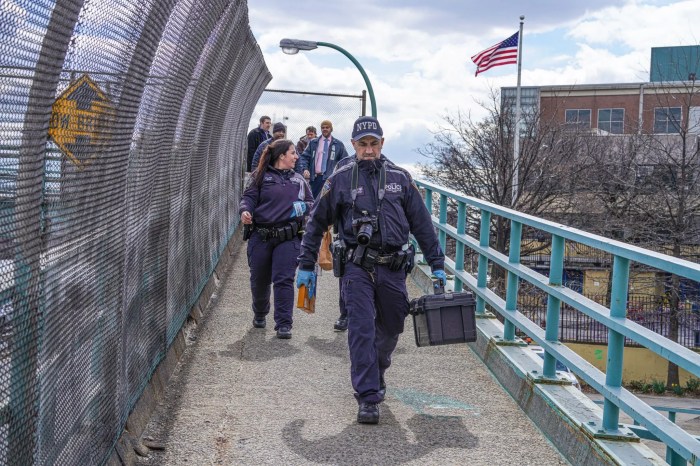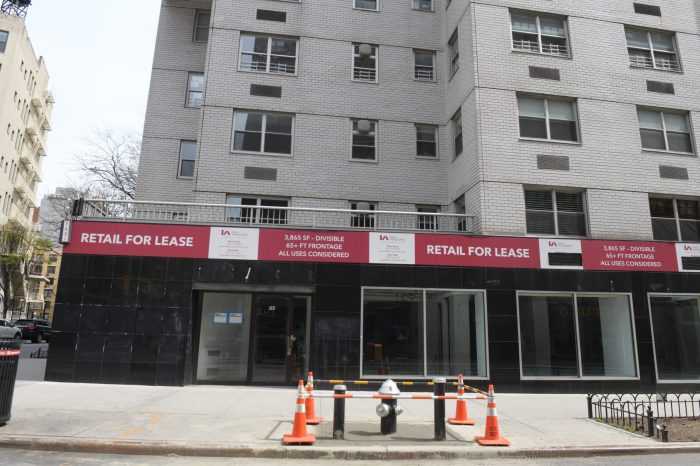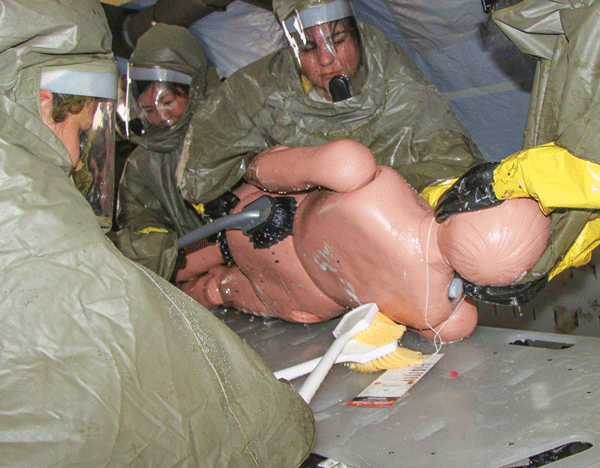
BY LINCOLN ANDERSON | The full extent of what had happened wasn’t immediately clear — only that a chemical explosion of unknown nature had hit Lower Manhattan.
Whatever it was, the medical staff were ready. They wore protective equipment — hoods, respirators, full-body plastic suits, gloves and booties — to safeguard them from exposure. A decontamination tent had been set up and stood at the ready in the outdoor ambulance bay.
Suddenly, a surge of patients arrived from the disaster scene. Some were the “walking wounded,” ambulatory, clutching injured limbs, or with hands clamped over their ears — deafened by an explosion — some wailing in pain.
Clinicians quickly triaged them, putting tags around necks stating their various conditions, and directing them to a decontamination room with showers. They were told to bag their clothes, with ID numbers, then don hospital gowns after showering, then go inside the facility for assessment and treatment.
Others, in more serious condition, were wheeled up on lightweight, disposable plastic stretchers. Tags on their wrists labeled their status, such as, “severe pain,” “confused” or “unconscious.”
These latter individuals were put through the tent. Once inside the blue tubular enclosure, their clothes were immediately cut off their bodies by a team of about eight medics, and the individuals were then sprayed with water and (a bit like a carwash) scrubbed down with brushes, to decontaminate them. They were then placed on a clean stretcher and sent inside to the resuscitation room for medical care.
However, in truth, these nonambulatory patients were lifeless mannequins. And the ambulatory victims were playacting 14- and 15-year-old students from the Institute for Health Professions at Cambria Heights, Queens — and they didn’t actually take showers or change out of the dark-blue scrubs they were wearing.
The medical staff, though, was real.
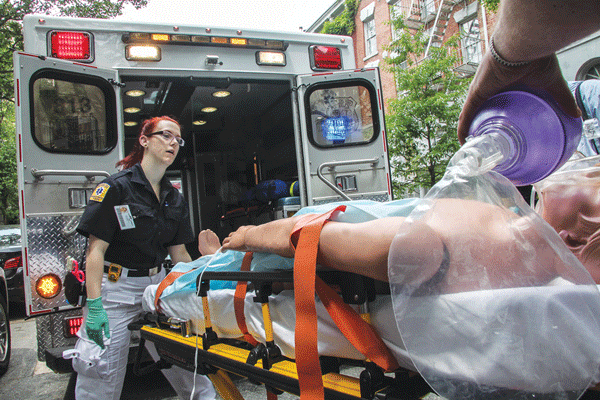
What it was, in fact, was a real-time disaster drill early last Friday afternoon.
The location was the new Lenox Hill HealthPlex, at W. 12th St. and Seventh Ave. Manhattan’s first freestanding emergency center, it’s expected to open sometime in July.
It’s anticipated that 90 to 92 percent of the predicted 45,000 patients the emergency center sees annually will be treated and released, with the rest needing to be transported to hospitals for a higher level of care.
But in the event of a disaster, the HealthPlex will be here also to help out. Although last Friday’s simulation was for a chemical explosion, the facility would also be able to help respond to biological and radiological incidents.
The center received 20 patients during the drill, 10 each ambulatory and nonambulatory. Ambulatory patients who were treated and cleared to leave, were allowed to walk out the complex’s W. 13th St. doors. Nonambulatory patients needing further care were sent by ambulance down to New York-Presbyterian Hospital — the borough’s only acute-care hospital south of 16th St. — at 83 Gold St. While Lenox Hill and New York-Presbyterian are competing health systems, they cooperated for the drill.
Ambulances from both North Shore-LIJ and NY-Presbyterian participated in the simulation. The mannequins needing to be transported were loaded into the vehicles on W. 13th St. near the entrance to the L.G.B.T. Community Center.
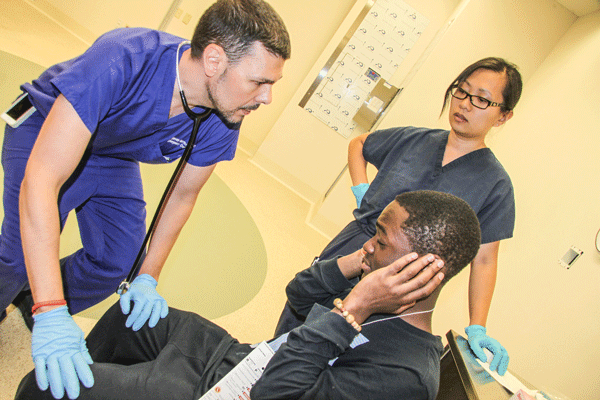
However, before the simulated patients were transported to “Presby,” as it’s called in medical lingo, their wrists were banded with an e-FINDS bracelet, which has a barcode with their name and date of birth. A new tracking system, touted as secure and confidential, the scannable bracelets identify the location of patients in real time, as they are treated and transferred between locations. The e-FINDS system grew out of problems during Superstorm Sandy, when some patients were lost in the shuffle during the chaos.
Last Friday’s emergency-preparedness drill in the Village was overseen by top officials from NS-LIJ, the major New York-area health system that has renovated the former St. Vincent’s O’Toole Building as a stand-alone emergency center, complete with an emergency room. The facility also has backup rooftop generators that would kick in during a blackout. (The generators are on the rooftop, again, because of lessons learned from Sandy.)
“They put a tremendous amount of money into this place,” said Scott Strauss, the health system’s director of protective services, before the drill began. “It’s not a Level 1 trauma center, unfortunately, with the closing of St. Vincent’s. But I think the neighborhood residents will be very happy having an emergency room.”
In fact, NS-LIJ spent $150 million to create the new facility.
Strauss was formerly a member of the Police Department’s elite Emergency Service Unit — the heavily armed “SWAT” officers — assigned to E.S.U. Truck 1, a.k.a. “Hollywood,” which covered Manhattan south of 59th St.
“I’m a retired cop,” he said. “I used to work down here. We were at St. Vinny’s a lot. This is going to be a busy place,” he predicted of the HealthPlex.
After 45 minutes, the drill was winding down. Inside the heart of the 30,000-square-foot HealthPlex emergency center, as other personnel clustered around him, Dr. Eric Cruzen, the facility’s medical director, held a walkie-talkie, as Tony Egan, NS-LIJ’s manager of security and emergency training, held a telephone to his ear.
Nearby, a man was jotting notes on a whiteboard, tracking patients’ whereabouts.
A “mobile risk center,” with “situational awareness software,” had also been set up, basically, several computer screens that were tracking any crises in the surrounding area, plus a device that could take diverse radio systems and make them communicate with each other — which had been a problem on 9/11. Weather software was charting wind direction, important to know if there is a chemical incident.
“This is Entity Command,” Cruzen spoke into the walkie-talkie. “We have no further information at this time. So far, we haven’t lost anybody.”
“We just got a call from New York City O.E.M. [Office of Emergency Management],” Egan relayed to Cruzen. “All victims have been removed from the scene. We will be receiving no more patients.”
“At this time,” Cruzen announced, “everyone in [protective] suits will receive instructions for dropping of suits.”
There was scattered applause. The group untensed, began to break up. The “emergency” was over.
Afterward, Cruzen assured that all the individuals participating in the drill were actual doctors, physician assistants, nurses and patient-care technicians who will be working at the new HealthPlex.
He explained that, even though the emergency center has a decontamination room, the outdoor tent was set up so that many patients could be decontaminated at once.
Although some community members have derided the new stand-alone Seventh Ave. emergency center as an “urgent-care center on steroids,” NS-LIJ officials assure there is no comparison. Unlike the HealthPlex, urgent-care centers don’t have disaster-preparedness or specially emergency-trained doctors and nurses. The HealthPlex is also capable of caring for psychiatric patients.
And the center will operate 24/7, 365 days a year, and will be a receiver for the city’s 911 system. It will also be able to draw on the resources of the state’s second-largest private employer and the nation’s tenth-largest healthcare system, with 18 hospitals.
“While the HealthPlex wasn’t designed to be a trauma center, it does have the ability to provide a high level of response should a natural — or manmade — disaster strike,” Cruzen stated. “We have advanced decontamination equipment, specialized training and the ability to provide immediate response, whatever the situation.
“The HealthPlex was designed to serve and protect its community.”











